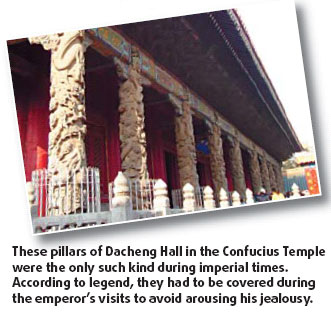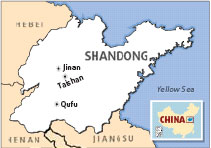| Tools: Save | Print | E-mail | Most Read |
| High Adventure at Taishan |
| Adjust font size: |
Holidaymakers with sky-high ambitions will find mountains of fun on Taishan, in east Confucius scaled
Jade Emperor's Peak, the highest point of Taishan, bustles just before sunrise. "Sun worshipers" flock to the summit of this mountain daily to watch the sun rise and set from above the cloud swath. Photos by Erik Nilsson But the journey is well worth the legwork, as According to many ancient Chinese creation myths, Taishan was the point from which the world originated. Today, the mountain is still revered as the premium Traditional belief also maintained that each day began with the sun rising from Taishan to start its westward journey across the world. Today, droves of "sun worshipers" surmount the summit to retrace history and enjoy its geological fantasticality. But most of all, they make the pilgrimage to see the mighty mountain's legendary sunrises paint the heavens from above the cloud blankets. Scaling the precipice was once a rite of passage for emperors, including Qianlong of the Qing Dynasty (1644-1911), who is said to have ascended the peak 11 times. Rising from 150 meters above sea level in the city of Those hoping for a journey of historical proportions should follow the Here, more than 6,000 steps snake up This route begins at the Traveling upwards, visitors encounter the Dai Zong Archway, the
Those seeking something a bit more off the beaten path can slug up the wilder However, they'll come across few historically significant spots, aside from the Hikers who choose this route in spring or summer will trounce through one of the most amazing wildflower bouquets nature can muster. In springtime, a powerful floral fragrance wafts through the air along this route. Reserved for absolute adventurers is the treacherous This pathway winds under the shadows of centuries-old pines and several other peaks, including Those who are unable or unwilling to absolutely abuse their feet can catch a bus (18 yuan, $2.3) up the mountain to Zhong Tian Men (Middle Heaven's Gate), which is also the destination point of the western route.
Upon reaching Zhong Tian Men, visitors can take an 11-minute cable car ride over mountain valleys to The western side of Upon taking a stone bridge eastward, sun worshipers will find something resembling a small but bustling town. Clusters of cookeries, souvenir stands, hotels and the occasional temple are nestled among the juts and crags of the peak. Skirting among these traditionally styled structures is an army of sun worshipers clad in PLA jackets, which can be rented for as little as 5 yuan (65 US cents) per night to seal out the chilly mountaintop winds. Sun worshipers can spend the night here, either in a profligately priced hotel (average cost is 1,400 yuan, or $182, per night for austere accommodations) or rent a tent for as little as 25 yuan ($3.3). Many mountaineers just crawl into the trenches scattered around this area and hunker down for the night huddling against perfect strangers. Since food and drinks must be lugged up the mountainside, the prices for these necessities on the peak could seem higher than its altitude.
But summer is the best time for flora fanatics to take the other cable car from the peak, because this is the time that the Peach Blossom Ravine earns its name. This ropeway terminates at a bus stop. Sun worshipers, history hounds and manic mountaineers who make the legendary ascent up Taishan will discover fun and adventure taken to new heights.
Getting there
Taxis in Most affordable three- and four-star hotels line Beiyuanjie north of the city, and the cost from the airport should not be more than 105 yuan ($13.7) unless traffic becomes congested. From here, fares to most sites including Qianfoshan, Daming Hu and Baotuquan should be less than 15 yuan ($2).
A bus to Tai'an should cost about 20 to 30 yuan ($2.6-3.9) and should take about an hour and a half. A bus to Qufu should cost less than 55 yuan ($7.2) and take less than two-and-a-half hours. The last bus from Tai'an to Jinan leaves at 7:30 pm, and the last bus from Qufu to Jinan leaves at 5:30 pm. Sun worshipers could find lodging on Taishan but might find the hotels on the mountainside to be exorbitant (about 1,400 yuan, or $182, per night on average for austere accommodations). A cheaper option is catching Zs in the rows of bunk beds lining these hotels' hallways (200-600 yuan, $26-78) or renting a tent (as low as 25 yuan, $3.3). Tai'an offers much cheaper accommodations in the city, but staying here could cut the time spent on the mountainside. (
|
| Tools: Save | Print | E-mail | Most Read |
 |
| Related Stories |
|
Product Directory China Search |
Country Search Hot Buys |





